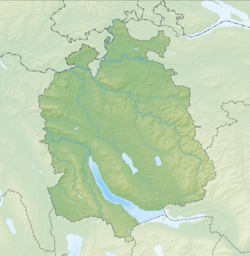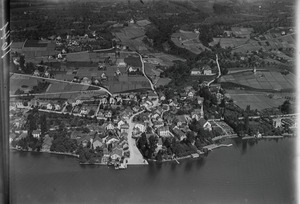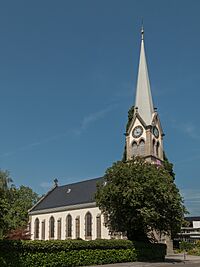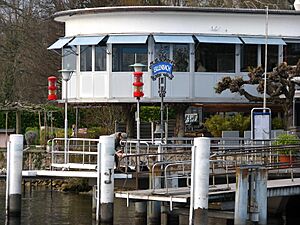Erlenbach, Switzerland facts for kids
Quick facts for kids
Erlenbach
|
||
|---|---|---|
 |
||
|
||
| Country | Switzerland | |
| Canton | Zurich | |
| District | Meilen | |
| Area | ||
| • Total | 2.89 km2 (1.12 sq mi) | |
| Elevation | 412 m (1,352 ft) | |
| Population
(Dec 2020 )
|
||
| • Total | 5,606 | |
| • Density | 1,940/km2 (5,024/sq mi) | |
| Postal code |
8703
|
|
| Surrounded by | Herrliberg, Küsnacht, Thalwil | |
| Twin towns | Erlenbach im Simmental (Switzerland), Erlenbach am Main (Germany) | |
Erlenbach is a small town, also called a municipality, located in the canton of Zürich in Switzerland. It's a beautiful place right on the northern shore of Lake Zurich.
Contents
History of Erlenbach
Erlenbach has a long and interesting history! People have lived here for more than 5,000 years. That's a really long time!
Early Settlements and Name Origin
The first time Erlenbach was likely mentioned was in the year 981. Back then, it might have been called Liber Heremi. Later, between 1173 and 1190, it was known as Erlibach. This name comes from the Erlen Bach, which is a stream that flows through the village.
During the time of Roman Empire, an important road passed right through what is now Erlenbach. Later, in the 6th century, a group of people called the Alemanni settled in the village. Around the year 1400, the big city of Zürich bought the land where Erlenbach is located.
Battles and Changes
Long ago, there were stories about two castles called Balp and Dachsberg in Erlenbach. However, today there are no signs left of them.
On October 6, 1445, a small fight happened in Erlenbach. It was called the Schlacht bey Ehrlibach. Troops from Zürich won against some people who were stealing wine. Later, in 1798, different armies stayed in the village. First, there were French troops, then Austrian, then Russian, and finally French troops again.
Growth of the Village
For a long time, until the mid-1800s, Erlenbach was a small village. It had less than 1,000 people. Most of them grew wine. In 1835, the first school was built, but it only had two classrooms.
After World War II, many people wanted to live in Erlenbach. Because of this, the number of people living there grew a lot!
Geography of Erlenbach
Erlenbach covers an area of about 3 square kilometers (which is about 1.16 square miles).
Land Use in Erlenbach
- About 25.7% of the land is used for farming.
- Around 26.7% is covered by forests.
- A large part, 47%, is used for buildings and roads.
- A very small part, 0.7%, is made up of things like rivers or mountains.
In 1996, about 37% of the total area was used for houses and other buildings. Roads and other ways to travel made up about 10.1%. A tiny part, 0.3%, was water, like streams and parts of the lake. In 2007, almost half (46.3%) of the town's area was being built on.
Location and Sections
Erlenbach is located on the north side of Lake Zurich. Across the lake from Erlenbach is the town of Thalwil. The village is built along the Erlen stream and also along the main road that connects Zürich and Rapperswil.
The municipality of Erlenbach includes the main village and other smaller areas. These include Wyden, Winkel, Isler, Bindschädler, and Lerchenberg.
People and Population in Erlenbach
Erlenbach has a population of about 5,700 people (as of 2022).
Population Details
In 2007, about 17.1% of the people living in Erlenbach were from other countries. In 2008, about 47.8% of the people were male, and 52.2% were female. Over the last 10 years, the number of people living in Erlenbach has grown by about 19.5%.
Most people in Erlenbach (86.3%) speak German. English is the second most common language (2.8%), and Italian is the third (2.7%).
Age and Education
Looking at the age of people in Erlenbach (in 2000):
- Children and teenagers (0–19 years old) make up 20.4% of the population.
- Adults (20–64 years old) make up 62.2%.
- Seniors (over 64 years old) make up 17.4%.
A large number of adults (about 82.3%) between 25 and 64 years old have finished high school or gone on to higher education, like university. There are 2,041 homes in Erlenbach.
Work and Jobs
Erlenbach has a low unemployment rate of 1.59%. This means most people who want to work can find jobs.
In 2005, here's how people worked:
- 60 people worked in farming and related jobs. There were about 10 businesses in this area.
- 204 people worked in manufacturing and construction. There were 33 businesses in this area.
- 1,131 people worked in services, like shops, offices, and healthcare. There were 227 businesses in this area.
In 2007, half of the working people had full-time jobs, and the other half worked part-time.
Religion
In 2008, there were 1,419 Catholics and 2,146 Protestants in Erlenbach.
According to the 2000 census:
- 47% of the people were Protestant. Most of them (45.9%) belonged to the Swiss Reformed Church.
- 29.2% of the people were Catholic.
- About 5.4% belonged to other religions.
- 15.7% said they did not have a religion or were atheist.
Population Over Time
Here's how the population of Erlenbach has changed over many years:
| Year | Population |
|---|---|
| 1400 | around 200 |
| 1764 | 682 |
| 1850 | 978 |
| 1888 | 944 |
| 1900 | 1,207 |
| 1910 | 1,510 |
| 1950 | 3,448 |
| 1970 | 4,523 |
| 1990 | 4,377 |
| 2000 | 4,609 |
Transportation in Erlenbach
The building of a railway line between Zürich and Rapperswil changed Erlenbach a lot. The village slowly changed from a farming community to a part of Zürich's bigger city area.
Erlenbach has two train stations: Erlenbach ZH and Winkel am Zürichsee. Both stations are part of the S-Bahn Zürich train network, on lines S6 and S16. You can also take fun boat trips from Zürich and Rapperswil, run by the Zürichsee-Schifffahrtsgesellschaft.
Cultural Heritage of Erlenbach
Erlenbach is home to a very special place called Erlenbach–Winkel. It's part of a bigger group of 56 Swiss sites that are recognized by UNESCO as a World Heritage Site. These sites are called Prehistoric pile dwellings around the Alps.
What are Pile Dwellings?
Pile dwellings are ancient villages that were built on stilts (or piles) over lakes or wetlands. The settlement in Erlenbach is also listed in the Swiss inventory of cultural property of national and regional significance as an important historical site.
Because the lake has grown bigger over time, the original wooden piles from these ancient homes are now about 4 to 7 meters (13 to 23 feet) under the water level of Lake Zurich. This makes them a fascinating look into how people lived thousands of years ago!
See also
 In Spanish: Erlenbach (Zúrich) para niños
In Spanish: Erlenbach (Zúrich) para niños







